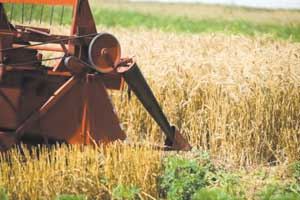|
2014 Wheat Harvest Has Mixed Outcomes
PRINCETON, KY.
Mother Nature threw some curve balls to the wheat crop over the growing season. Now at harvest time, some growers are finding out their crop safely weathered the season, while others are discovering they struck out.
The wheat growing season started off rocky for many producers when cool weather patterns during the fall delayed corn harvest and subsequent wheat planting. Record low temperatures during the winter slowed crop development and threatened to potentially delay harvest, said Carrie Knott, grain crops specialist with the University of Kentucky College of Agriculture, Food and Environment.
Fortunately, harvest is only slightly behind. As of June 30, the Kentucky office of the National Agricultural Statistics Service reported that 71 percent of the crop was harvested. This is just below the five-year harvest average of 78 percent.
With yields averaging around 70 bushels per acre and good test weights, many growers thought they had dodged a bullet. While most did, others are learning their crop didn’t come out of the season unscathed, as they are encountering high levels of the fungal toxin deoxynivalenol, also known as DON, in their crop.
“Typically, high levels of DON are correlated with high levels of Fusarium head blight,” said Don Hershman, UK extension plant pathologist. “The appearance of head blight on heads is usually visible in the field, but this year, symptom expression was minimal in many cases.”
So far, high levels of DON are in spotty locations across the state. Hershman said the high levels could be due to a combination of factors, many of which farmers could not control despite their best efforts.
The crop growth was extremely uneven this year, which lengthens the period of head emergence. The plant is most susceptible to Fusarium just after head emergence, when the crop begins to flower. The longer period could have exceeded the time that a foliar fungicide would be effective or may have resulted in only a portion of the wheat tillers receiving protection when they needed it.
The extensive cool and wet period this spring also caused growers to delay fungicide applications.
“This is a very common conundrum,” Hershman said. “The very conditions which favor head scab development and demand a fungicide application are the same conditions that make it difficult or even impossible to spray.”
The crop could also have been infected by the Fusarium pathogen later during grain fill.
“This is not an extremely common scenario, but when it does occur, it is usually associated with cool, wet weather during grain fill,” he said. “These are exactly the conditions experienced during much of the grain fill period for many fields throughout Western Kentucky this spring.”

For some
farmers, the
appearance
of their wheat crop was deceiving.
PHOTO: Matt Barton,
UK Agricultural
Communications
Due to a lack of symptoms, many growers are not discovering the issue until they arrive at the mill or grain elevator.
“Numerous reports in the western part of the state, where the majority of the wheat has been harvested, indicate problems with DON levels exceeding industry allowances,” Knott said. “There are several reports that DON levels are so high that loads are being rejected or penalized with significant price reductions.”
Growers who have harvested their crop but have yet to market their grain can get their DON levels tested if they have concerns. They can contact their local UK Cooperative Extension Service office for details. ∆
|
|